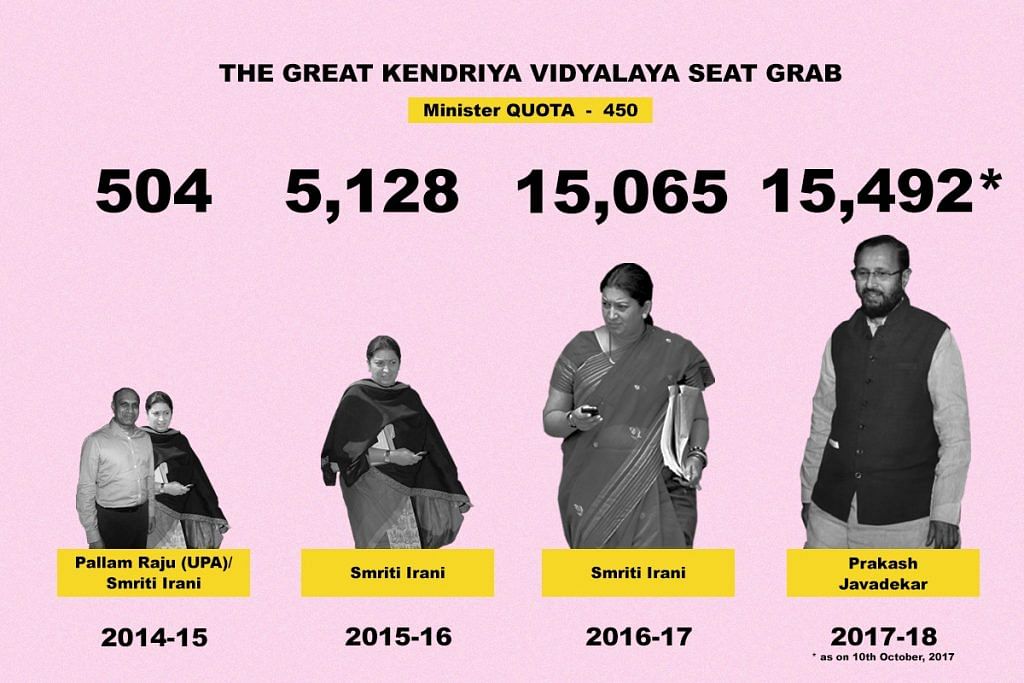HRD minister has yearly quota of 450 seats in KVs. Smriti Irani and Prakash Javadekar sent 35,685 in 3 years.
New Delhi: Over the last three years, human resource development ministers Smriti Irani and Prakash Javadekar have sought to give away a humongous 35,685 seats in the Kendriya Vidyalaya (KV) schools under a special HRD minister’s ‘discretionary’ quota. This is about 25 times—or roughly 2,500 per cent—over the quota ceiling of 450 seats per year.
The board that manages the central government’s prestigious KVs admitted half of the ministers’ candidates and is struggling with the rest.
Important point: The board—the Kendriya Vidyalaya Sanghatan (KVS)—is headed by none else than the HRD minister. And the quota limit of 450 was also fixed by Irani when she was HRD minister in 2014.
According to information accessed by ThePrint under the RTI Act:
· In her first full academic year as HRD minister in 2015-16, Irani recommended admissions to 5,128 students against her quota of 450 such admissions. Of these, the KVS could admit only 3,500.
· The next year, 2016-17, Irani pushed 15,065 cases for admission against the same quota of 450 seats. This year, the KVS could admit more than 8,000 students recommended by the minister.
· Javadekar, who took over from Irani in July 2016, recommended 15,492 admissions for the academic year 2017-18 until 10 October 2017 while his quota remained at 450 seats. Although KVS has not yet compiled data for the number of admissions given under the minister’s quota, sources in the know said it is expected to be around 8,000 this year as well.
“In the following years (2015-16, 2016-17 and 2017-18) more than entitlement recommendations were received from MHRD (Ministry of Human Resource Development),” KVS said in its RTI reply.
Power of the minister
Generally, the KVS tries to give admission to all cases recommended by the minister. However, it has to stop after a point considering class strength and the capacity of a school.
KVS rules say the KVS board of governors has to approve the admission of students under the HRD minister’s discretionary quota in excess of the limit of 450. The twist though is that this board of governors is headed by the HRD minister.
Both Irani and Javadekar did not respond to queries from ThePrint despite repeated reminders. The KVS commissioner also did not reply to requests for comment.
But official sources told ThePrint that the KVS had red-flagged the issue to the minister’s office each time the quota ceiling was breached. The KVS, however, refused to share any information on this aspect in its RTI reply.
Schools in demand
There are more than 1,100 Kendriya Vidyalayas catering to the schooling needs of children of central government employees with transferable jobs. These schools admit about 1.5 lakh new students every year, about 1 lakh of them in class 1.
Besides the HRD minister, MPs can recommend up to 10 admissions per year and as many as 8,000 admissions are done each year from the MPs’ quota.
The special dispensation quota for the HRD minister was started sometime in 1975. While KVS said it did not have old records on admissions details, it said the quota has been exceeded consistently since 2014-15.
The Kendriya Vidyalayas have always been much sought after and every HRD minister has had to deal with a pile of admission requests. The discretionary quota was set at 1,000 admissions until Arjun Singh, who was HRD minister in UPA-1, raised it to 1,200.
His successor Kapil Sibal on the other hand went on to surrender the quota, arguing for complete meritocracy. Pallam Raju, who followed Sibal, is said to have recommended some admissions without reviving the quota.
When Irani took over as HRD minister in 2014, she revived the quota with a ceiling of 450 admissions, but went on to breach it herself. Javadekar ended up outdoing Irani even though he claimed he wanted to reform the KV system.
